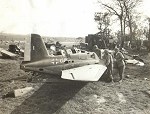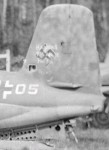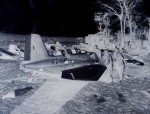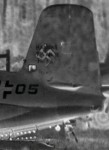This page is dedicated to Komet 'White 05', the Komet that I wanted to build in 1/72 and the Komet that made me start this site. Even after putting a lot of research into the Komet, this particular aircraft remains a very special aircraft. For a reason unknown to me it was the subject of many films, which illustrate large parts of its career. Another interesting aspect is that is one of the first group of Komets built, and it survived until after the war. It most likely had a rather strange colors applied to it. And lastly, it was used for Jagerfaust testing, which also ended its career.
This particular aircraft had the following identities:
The first sign of life are several pieces of film footage showing a light-colored PK+QP in use by Erprobungskommando 16 at Bad Zwischenahn. It is shown in at least four pieces of film:
The markings are simple: Balkenkreuze in the standard positions, PK+QP around the rear fuselage Balkenkreuz and on the lower wing (see 'Wings of Fire - The Messerschmitt Me-163' DVD). 'V-45' in a rather small script at the base of the fin, with an undetermined suffix. The color is a bit of a problem. Possible colors are RLM 65, RLM 76 and RLM 02. I know little of colors of test aircraft, and I hope some more knowledgeable people will help me here.
The same aircraft, but now camouflaged, appears in a dark camouflage in a number of pieces of film. My guess is that the camouflage was applied somewhere during the summer. The reason for camouflaging aircraft of a non-operational test unit such as EK16 is not completely clear. It could be they did test work against real enemy aircraft, or perhaps airfield camouflage became important because of roaming Allied fighter-bombers.
1. | ||||||
| ||||||
2. | ||||||
| ||||||
3. | ||||||
| ||||||
4. | ||||||
| ||||||
5. | ||||||
| ||||||
A combination of reports in books by Mano Ziegler, Jeffrey Ethell and Stephen Ransom revealed another hugely interesting aspect of 'White 05'. After arriving at Brandis, one of EK16's few remaining tasks was weapons development and testing. The very high speed of the Komet made conventional canon attacks difficult and ineffective, and alternative weapons were needed. R4M rockets had been tested on an Me 163A at Udetfeld successfully, but another idea had popped up. Armaments engineer Dr. Langweiler had come up with the idea of firing heavy shells verticaly into the lower sides of bombers, the system being triggered by the bomber's shadow passing over an optical sensor. The pilot only had to pass underneath a bomber and the system would do the rest. Dr. Langeweiler had come to Brandis and together with EK16's armaments test pilot Lt. August Hachtel he went to work. The system was named 'Sondergerät (Special Device) 500 Jagdfaust', also referred to as 'Jägerfaust'.
A trial installation was built into a Fw 190, with a barrel in each wing. Lt Hachtel flew the Fw 190 at low altitude under a 2 meter wide fabric banner held by balloons. The banner showed 2 holes in this first test! Two tubes were added, and the second and third test run resulted in 3 and 4 holes respectively. More tubes were added up to a total of eight, resulting in 7 holes. The only problem was the cracking of the canopy due to the blast of the firing tubes.
Installation in a Komet was next, and this happened to be 'White 05'. It was fitted with 5 vertical tubes in each wing root. The problem of the canopy cracking was solved by putting an electronic delay in the firing of the tubes. In the mean time the balloons had been forbidden, and the banner was held by two poles, at an even lower altitude then the balloon-held banner. The first 'live' firing took place on 24 December 1944, with all 10 barrels loaded. But disaster struck when 'White 05' was diving for a pass underneath the banner. Wing shading in a turn (or alternatively a dark cloud) caused the system to fire prematurely. Worse, all 10 tubes fired simultaneously because the delay had not been installed. The canopy was blasted off, and the Komet pitched violently. Half blinded, Hachtel still managed a crash landing; he was found besides the aircraft, unconsious and with a damaged spine. 'White 05' was damaged considerably, Ziegler reports 'stark zerstörte Machine' (page 157, 1996 issue), but it was probably not as bad as that. In Me 163 Volume One Ransom and Cammann it is listed as 40% damaged.
The flight logs published in Me 163 Volume One (page 215) show that at least one more flight was made with White 05, on 8 April 1945, piloted by Uffz. Harald Kuhn. I think that a life span of almost a year still isn't bad for an aircraft as volatile as the Me 163B! The only other Versuch-Komets still flying in April 1945 were V6, V15 and V40.
The last chapter in the life of 'White 05' came to light in Stephen Ransom's book about the history of Brandis. It features two pictures of 'White 05' made by US soldiers after the capture of Brandis. For a long time I thought 'White 05' was found on the Brandis scrap heap, but possibly that is not correct. It's likely the whole airfield was in disarray, looking like a scrap heap. According to an intelligence report, all 30 Komets found on the airbase were destroyed by the Germans by blowing up or torching. 'White 05' doesn't appear to be damaged deliberatly. It's lacking most of the wing root fairings, the skid fairing skins are missing, the canopy and rear view windows are absent.
The first photo was made on 2 May, the second was made somewhere in May, the third and fourth in June. The deterioration is considerable. The pictures show some interesting details. The canopy is missing, as are most of the wing roots panels. Some holes are visible in the front part of the wing roots panel. The original 30 mm cannon port is visible on the leading edge. Above and slightly inboard of it , another hole is visible. This has the correct position for the boresight installation of the cannon according to the handbook, but I know of no other picture of 'White 05' or any other Komet that shows it open. The pictures also quite clearly show two different colors used on the top side.

|

|

|

|
Another interesting photo (not publishable) appeared on Ebay in January 2007, and that showed a few more interesting details. Firstly, there are no Jägerfaust tubes to be seen in the wing, assuming that they were installed just outside the wing tanks, right down the iron cross marking as seen in this Brandis capture photo. Secondly, it is clear to see that 'White 05' had wings with short-span trim flaps.
The Brigham Young University has the collection of combat photographer J. Malan Heslop online. Heslop photographed Brandis after its capture, and among the photographs is the wreck of 'White 05' (courtesy of Richard Aigner). Rather than leave it there hidden in the archive, I took the liberty of posting a few detail views here.

|

|

|

|
The pictures shown on this page allow an analysis to be made of the camouflage pattern and colors.
First the overall light grey color of PK+QP. Likely colors are RLM 65, 76 and 02. Personally I would strike 02 first; photos that I've seen of 02 colored aircraft (prototypes) show a warmer color. That leaves 65 and 76, and these are difficult to distinguish. If I have to choose, I would say 76, because of the lightness of the color.
Moving on the top colors. All modelling references I've seen so far (AeroDetail book, Koku Fan magazine, Aeromaster decals) state that this aircraft was painted in RLM 81/82/76, the late war fighter colors. Unfortunately, they must be wrong. The camouflage was applied during the summer of 1944, some months before the introduction of RLM 81/82/83 according to David E. Brown's extensive and excellent work 'Late-War Luftwaffe Fighter Camouflage - Commentary on the Evolution and Usage of Luftwaffe RLM Colours 81, 82 & 83'. What options are left then for the top side colors?
Two likely color combinations are mid-war day-fighter colors RLM 74 and RLM 75, or the early-war fighter colors and standard bomber colors RLM 70 and RLM 71. The last option appears quite illogical, since no fighters were painted in these colors in since 1941. I compared the pictures to many photographs of aircraft with known colors, both early-war 70/71/65 and mid-war 74/75/76. And there was only one answer possible: this aircraft was painted in RLM 70/71! The low contrast between the colors, and the very dark appearance support this. It could be reasoned that the 'old' greens 70 and 71 are a good choice for airfield camouflage, better than the greys 74 and 75. Also, Bad Zwischenahn did house a Ju 88 bomber unit (KG30) and a weather flight with He 111 and Ju 88 in the summer of 1944, so EK16 could have borrowed 'bomber' paint from them.
The camouflage pattern is difficult to distinguish due to the low contrast between the colors. Some pictures almost suggest a solid color, but the June 1945 photo shows clearly that two colors were used. The drawing below shows my first attempt at sketching the pattern, but it needs a revision!

|
The mottling pattern on the tail is clearly visible in most pictures, and the pattern could be drawn up easily (watch this space). The colors however are difficult to judge. In some pictures they appear very dark, in other quite light. Apparently the contrast and brightness of the pictures varies considerably; another valuable lesson in studying black and white pictures! My feeling is that they are one of the the greens, 70 or 71.
Luigi Mazzola from Italy modified some of the above photos by inverting the colors, to better discriminate the camouflage pattern.

|

|

|

|

|

|

|